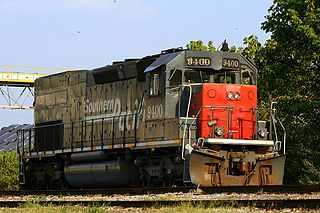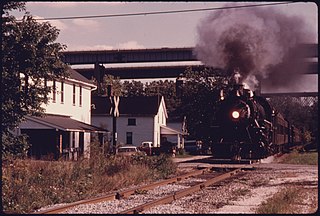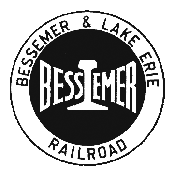
The Grand Trunk Western Railroad Company was an American subsidiary of the Canadian National Railway operating in Michigan, Illinois, Indiana, and Ohio. Since a corporate restructuring in 1971, the railroad has been under CN's subsidiary holding company, the Grand Trunk Corporation. Grand Trunk Western's routes are part of CN's Michigan Division. Its primary mainline between Chicago and Port Huron, Michigan serves as a connection between railroad interchanges in Chicago and rail lines in eastern Canada and the Northeastern United States. The railroad's extensive trackage in Detroit and across southern Michigan has made it an essential link for the automotive industry as a hauler of parts and automobiles from manufacturing plants.

The Duluth, Missabe and Iron Range Railway (DM&IR), informally known as the Missabe Road, was a railroad operating in northern Minnesota and Wisconsin that used to haul iron ore and later taconite to the Great Lakes ports of Duluth and Two Harbors, Minnesota. Control of the railway was acquired on May 10, 2004, by the Canadian National Railway (CN) when it purchased the assets of Great Lakes Transportation.

The Elgin, Joliet and Eastern Railway was a Class I railroad, operating between Waukegan, Illinois and Gary, Indiana. The railroad served as a link between Class I railroads traveling to and from Chicago, although it operated almost entirely within the city's suburbs, and only entered Chicago where it served the U.S. Steel South Works on the shores of Lake Michigan. Nicknames for the railroad included "The J" and "The Chicago Outer Belt Line". At the end of 1970, the EJ&E operated 164 miles of track and carried 848 million ton-miles of revenue freight in that year alone.
Great Lakes Transportation (GLT) was a group of transportation-related companies primarily consisting of rail and water carriers catering to the needs of the steel making industry centered on the Great Lakes of North America. The holding company was acquired by Canadian National Railway in 2004.
The Pittsburgh and Lake Erie Railroad, also known as the "Little Giant", was formed on May 11, 1875. Company headquarters were located in Pittsburgh, Pennsylvania. The line connected Pittsburgh in the east with Youngstown, Ohio in the Haselton neighborhood in the west and Connellsville, Pennsylvania to the east. It did not reach Lake Erie until the formation of Conrail in 1976. The P&LE was known as the "Little Giant" since the tonnage that it moved was out of proportion to its route mileage. While it operated around one tenth of one percent of the nation's railroad miles, it hauled around one percent of its tonnage. This was largely because the P&LE served the steel mills of the greater Pittsburgh area, which consumed and shipped vast amounts of materials. It was a specialized railroad deriving much of its revenue from coal, coke, iron ore, limestone, and steel. The eventual closure of the steel mills led to the end of the P&LE as an independent line in 1992.
The Wheeling and Lake Erie Railway is a Class II regional railroad that provides freight service, mainly in the areas of Northern Ohio and Western Pennsylvania. It took its name from the former Wheeling and Lake Erie Railway, most of which it bought from the Norfolk and Western Railway in 1990.

The EMD SD18 is a 6-axle diesel locomotive built by General Motors Electro-Motive Division between April 1960 and March 1963. Power was provided by an EMD 567D1 16-cylinder engine which generated 1,800 hp (1.3 MW).

The SD45T-2 is a model of diesel-electric locomotive built by EMD for the Southern Pacific Railroad. Like the later SD40T-2 it is colloquially nicknamed a tunnel motor. 247 total units were produced from February 1972 to June 1975, including 84 for SP's subsidiary Cotton Belt. From April 1986 to December 1989, 126 were rebuilt and re-designated as SD45T-2R, including 24 for Cotton Belt.

The Lake Superior Railroad Museum is a railroad museum in Duluth, Minnesota, United States.

The North Shore Scenic Railroad is a heritage railroad that operates between Duluth and Two Harbors, Minnesota, United States, along 28 miles (45 km) of the Lakefront Line, once part of the Duluth, Missabe and Iron Range Railroad.

Pittsburgh, surrounded by rivers and hills, has a unique transportation infrastructure that includes roads, tunnels, bridges, railroads, inclines, bike paths, and stairways. The hills and rivers form many barriers to transportation within the city.

The Union Railroad is a Class III switching railroad located in Allegheny County in Western Pennsylvania. The company is owned by Transtar, Inc., which is itself a subsidiary of Fortress Transportation and Infrastructure Investors, after being purchased from United States Steel in 1988. The railroad's primary customers are the three plants of the USS Mon Valley Works, the USS Edgar Thomson Steel Works, the USS Irvin Works and the USS Clairton Works.
The Erie and Pittsburgh Railroad was a railroad based in Erie, Pennsylvania incorporated on April 1, 1858. Operations began in March 1860. It operated jointly with Buffalo and State Line Railroad from an indeterminate date until February 28, 1870, in connection with the latter's commitment, along with the Erie and North East Railroad, to complete track construction between Jamestown, Pennsylvania, and Girard, Pennsylvania. The railroad was leased as of April 1, 1870, by the Pennsylvania Railroad.

The Beaver and Erie Canal, also known as the Erie Extension Canal, was part of the Pennsylvania Canal system and consisted of three sections: the Beaver Division, the Shenango Division, and the Conneaut Division. The canal ran 136 miles (219 km) north–south near the western edge of the state from the Ohio River to Lake Erie through Beaver County, Lawrence County, Mercer County, Crawford County, and Erie County, Pennsylvania.

The SS Marquette & Bessemer No. 2 was a train ferry that sank with the loss of between 30 and 38 lives on Lake Erie on December 8, 1909.

Grand Trunk Western No. 4070 is a class "S-3-a" 2-8-2 type USRA Light Mikado steam locomotive, originally built by the American Locomotive Company (ALCO) in December 1918 for the Grand Trunk Railway as No. 474, later re-numbered to 3734 by the Grand Trunk Western Railroad, after the GT was absorbed into Canadian National (CN). In the late 1950s the locomotive received a larger tender from an S-3-c class locomotive, and re-numbered to 4070. As of 2023, the locomotive is undergoing restoration by the Midwest Railway Preservation Society.
The Atlantic City Mine Railroad was a private carrier mine railroad that operated in Wyoming from 1962 until 1983. Owned and operated by U.S. Steel, the railroad extended 76.7 miles from a connection with the Union Pacific Railroad in southwestern Wyoming to an iron ore mine north of Atlantic City, Wyoming. One notable aspect of the railroad was its crossing of the Continental Divide at South Pass, Wyoming. Another was the railroad's use of EMD F7 locomotives, quite often in the iconic A-B-B-B-B-A configurations, painted in U.S. Steel's own yellow and black livery.

The Harriet B. was a wooden-hulled barge that served on the Great Lakes of North America, originally as the railroad ferry Shenango No.2, then a bulk carrier and finally as an unpowered barge. She sank four miles off Two Harbors, Minnesota on May 3, 1922, after being rammed by the steel freighter Quincy A. Shaw. Her wreck was accidentally located upright and intact in 2005 in 656 feet (200 m) of water. On August 9, 2018, the wreck of the Harriet B. was listed on the National Register of Historic Places.
Bessemer and Lake Erie Railroad No. 643 is the sole survivor of the class H-1 2-10-4 "Texas type" steam locomotives built by the Baldwin Locomotive Works in 1944 for the Bessemer and Lake Erie Railroad, primarily used for hauling heavy mainline freight trains in Pennsylvania and Ohio, until retirement in 1952. It is now owned privately by the Age of Steam Roundhouse Museum in Sugarcreek, Ohio, which purchased No. 643 in 2019, and is currently in the process of being moved to Sugarcreek piece-by-piece from McKees Rocks, Pennsylvania.
















